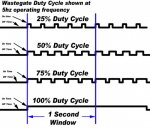Just had a revelation that I have been looking at this on a small scope and incorrectly! We really don't know exactly what the wastegate is doing since we can't measure the wastegate angle or stroke that is being achieved at the target boost pressure. What the wastegate duty cycle is actually referencing is the Boost Control Solenoid. So at 0% WDC <----- The control solenoid is letting no boost/vacuum through to the wastegate, allowing it to do its job and stay closed. At %100 WDC <------ the solenoid is effectively fully open allowing full boost/vacuum through to the wastegate telling it to open.
Now what we don't know is at between %0-100 of WDC, what the actual actuator is doing. Now and actuators movement is normally measured in degree of angle (how much lift/opening the wastegate flapper valve has opened) or stroke distance of the rod. I conferred with a colleague who does tuning and know engine management systems for OEM's really well and what he says is that most tunes on factory vehicles react the same way. You will have a boost spike then it will taper off and show a %90-100 Wastegate duty cycle to allow the wastegate to do its job depending on certain factors, but mainly for reliability and emissions reasons. Unless we use an electronic wastegate actuator, we cannot monitor stroke of the rod or degrees of opening at certain duty cycles and engine load/RPM.
Now the question is that we all want to know, is if by adding wastegate pre-load or going to a stiffer wastegate, can we product more USEABLE PSI/Lbs Min of airflow out of this turbo, or is it at its cap. This question will only be solved by adding a different wastegate and trying to command and tune for higher boost pressures.
So to answer your question Jeff, it all depends on how wastegate duty cycle is measured and in this situation, it really wont have a negative and or positive performance affect commanding so much wastegate duty cycle. All it is telling us is that on their tunes, the tuner (who ever it is) has requested to make no more boost at that current point in RPM, Engine load, throttle input. Now why they haven't requested anymore boost is the question and my assumption is that it is because through tuning the found the point at where they have demanded more boost and either no more boost was made, or most boost was made and no more power was made.
So still-the only option on the MRX is to change wastegates and see if more usable boost can be made or not.

![Wink [wink] [wink]](/images/smilies/wink.gif)
